Teaching pet birds to talk can be a rewarding and bonding experience. While some birds may pick up human speech quickly, others may take months or even years to say their first word. It is important to establish a training routine and work with your bird every day. Pay attention to the vocalizations your bird makes during the day and try teaching something easier, like whistling, if speech training seems to be taking a long time. Remember that even if your bird never speaks a word, the training and interaction still strengthen the bond between you and your pet.
Key Takeaways:
- Teaching pet birds to talk requires patience and consistency.
- Establish a training routine and work with your bird every day.
- Pay attention to the vocalizations your bird makes and adjust your training accordingly.
- Consider teaching easier tasks, like whistling, if speech training is taking longer than expected.
- Remember that the training process strengthens the bond between you and your pet, regardless of whether they learn to talk.
The Communication Skills of Birds
In the wild, birds possess remarkable communication skills that allow them to identify and bond with their flock. These skills become even more fascinating when birds are kept as pets, as they attempt to communicate with their human owners by mimicking the sounds they hear. Birds listen to the noises people make and strive to fit in with their human “flock.” Teaching a pet bird to talk presents a unique opportunity to establish a special and enduring relationship.
While African grey and Amazon parrots are known for their exceptional ability to learn human speech, other bird species can also be taught. The communication skills of birds are not limited to vocalizations alone; they also include body language and interactive behaviors that strengthen the bond between birds and their human companions.
When pet birds attempt to mimic human speech, it is not merely an imitation. It is their way of trying to communicate and connect with their owners on a deeper level. By teaching a bird to talk, you are allowing it to engage in meaningful communication with you, resulting in a more fulfilling relationship.
So, how do birds communicate with humans? They observe and listen, picking up on the sounds and phrases repeated by their owners. Through practice and patient training, they gradually learn to reproduce those sounds, creating a language unique to their bond with you.
Species Variation and Talking Ability
While some bird species are more inclined to learn to talk, it is essential to note that all birds have the potential to communicate vocally. African grey and Amazon parrots are particularly renowned for their talking abilities, often amassing impressive vocabularies. However, other species, such as budgerigars and cockatiels, have also been taught to mimic human speech with consistent training and reinforcement.
It is crucial to remember that each bird is an individual, and their ability to talk may vary. Factors such as age, temperament, and training consistency can influence their language acquisition. Some birds may quickly grasp words and phrases, while others may require more time and patience. Regardless of their species or individual talking abilities, the training process provides an excellent opportunity for you to bond and communicate with your feathered companion on a whole new level.
The Bonding Power of Bird Speech Training
Teaching a pet bird to talk not only allows them to communicate with you, but it also strengthens the bond between you and your feathered friend. It enables you to establish a unique form of social interaction, building trust, and deepening your connection. As you spend time together, repeating words and phrases and rewarding their efforts, your bird will begin to associate speech with positive experiences and attention from you.
Through consistent training, you can create a shared language that facilitates understanding and opens up new avenues for communication between you and your pet bird. This shared language goes beyond simple mimicry; it becomes a means for your bird to express its needs, desires, and emotions, enhancing the richness of your relationship.
Building a Strong Relationship
To teach your bird to talk effectively, it is crucial to build a strong and trusting relationship with your pet. Birds are social creatures and need to feel a deep bond and affection towards their owners in order to want to communicate. By establishing a positive and nurturing connection, you create an environment that encourages your bird to engage with you and learn to talk.
To build a strong relationship with your bird, there are several key strategies you can employ:
- Offer treats: One of the simplest ways to bond with your bird is through positive reinforcement with treats. Choose their favorite snacks, such as sunflower seeds or small pieces of fruit, and offer them as rewards during interaction sessions. This not only fosters a sense of trust but also associates you with pleasant experiences in their minds.
- Provide head scratches: Birds enjoy physical affection, and gentle head scratches can be a fantastic way to strengthen your bond. Pay attention to your bird’s body language and vocalizations to identify their preferred areas of petting.
- Use verbal praise: Verbal communication plays a crucial role in building a relationship with your pet bird. Speak to them in a soft and soothing voice, using words of encouragement and praise. Your bird will start associating your voice with positive experiences and the desire to engage with you.
Another key element in building a strong bond with your bird is the tone of your voice during interactions. Using a high-pitched, sing-song voice can engage your bird’s attention and reinforce the positive connection between you both.
Remember, building a positive relationship with your bird establishes you as a trusted friend and a member of their flock. Nurture this bond through treats, head scratches, verbal praise, and a warm and welcoming tone of voice. By investing time and effort in building a strong relationship, you create the foundation for successful bird training and the development of their talking abilities.
Choosing the Right Rewards
When it comes to training your bird to talk, selecting the appropriate rewards is crucial. Most birds are highly motivated by food treats, so it’s essential to experiment with different options to find what truly captures their attention. Some popular choices include peanuts, sunflower seeds, or small pieces of crackers. However, every bird has its own preferences, so take the time to determine what your bird likes best.
Once you’ve identified the preferred reward, you can use it to reinforce the desired behaviors in your bird’s training. When your bird successfully mimics a word or performs a desired action, immediately provide the chosen treat as positive reinforcement. This encourages your bird to repeat the behavior to receive the reward again.
In addition to treats, it’s also important to provide your bird with attention and praise. Birds thrive on social interaction, and positive reinforcement in the form of verbal praise and affectionate gestures can be powerful motivators during training sessions.
Remember, the key to training your bird to talk is to make the experience enjoyable and rewarding. By choosing the right rewards and employing positive reinforcement techniques, you can effectively motivate your pet bird and make the training process a positive and engaging one.
| Reward | Description | Pros | Cons |
|---|---|---|---|
| Peanuts | A popular choice rich in protein and healthy fats. | – High-value reward for many birds – Nutrient-dense | – Potential allergen for some birds – Not suitable for birds with specific dietary restrictions |
| Sunflower Seeds | A favorite among birds, with a crunchy texture and pleasant taste. | – Highly palatable – Easily accessible | – High in fat, so should be used in moderation – May contribute to weight gain if overused |
| Small Cracker Pieces | Small, bite-sized crackers that birds find irresistible. | – Versatile and easy to portion – Can be broken into smaller pieces for small bird breeds | – May contain added salt or unhealthy additives in certain varieties – Birds may lose interest if the same cracker is used repetitively |
Picking a Starter Word and Repetition
When teaching your bird to talk, choosing a starter word is an important step. Opt for a word that is one or two syllables long, making it easier for your bird to mimic. Good starter words include “hello,” “hi,” and even your bird’s name. By selecting a simple, familiar word, your bird will be more likely to grasp and imitate it.
Once you have chosen a starter word, repetition is key. Throughout the day, consistently repeat the word using the same tone and inflection each time. This repetition helps your bird make connections and link the sound with positive interactions. It creates an environment where your bird feels encouraged to mimic you. Remember, birds pay attention and respond when they are given something to work for.
Incorporating rewards can further motivate your bird to imitate the starter word. Pair the word with a reward or treat, reinforcing the desired behavior. This positive reinforcement strengthens the association between the word and the reward, encouraging your bird to repeat the word more frequently.
Keep in mind that repetition should be used consistently and strategically. Find opportunities throughout the day to repeat the starter word, such as during play sessions or while offering treats. By repeating the word frequently, your bird will begin to associate the sound with positive experiences and strive to mimic it.
Benefits of Picking a Starter Word and Using Repetition
Repetition is the key to teaching a bird to talk. By picking a starter word and repeating it consistently, you provide your bird with a clear model to imitate. This process helps strengthen the bond between you and your pet bird while establishing a foundation for expanding their vocabulary.
Repetition is a powerful tool in bird training as it aids in memory retention and reinforcement of desired behaviors. It allows your bird to become familiar with the sound, rhythm, and melody of the starter word, making it easier for them to replicate it. The more your bird hears and associates the word with positive interactions, the more likely they are to try and mimic it themselves.
Remember, teaching your bird to talk requires patience and consistency. Celebrate small victories along the way and remain dedicated to the training process. With time and repetition, your bird will gradually learn to imitate the words and phrases you teach them, opening up a whole new world of communication between you and your feathered friend.
Reinforcing Desired Behaviors and Overcoming Challenges
In bird training, it is crucial to reinforce the desired behaviors and tackle the challenges that may arise. Birds are exceptional mimickers, and they may start imitating undesired words or sounds from their environment. Instead of reacting negatively, it is best to ignore the undesired words and turn your back or leave the room. Birds learn through reinforcement, so they will focus on words and sounds that are reinforced.
Patience and consistency are key in bird training. It is essential to focus on one behavior at a time to avoid overwhelming your feathered friend. By reinforcing the desired behaviors and providing positive feedback, you can encourage your bird to continue learning and expanding its vocabulary.
To exemplify the importance of reinforcement and overcoming challenges in bird training, let’s take a look at the following table:
| Reinforcing Behaviors | Challenges |
|---|---|
| Rewarding with treats and praise when your bird mimics a desired word or phrase | Birds imitating undesired words or sounds from their environment |
| Utilizing consistent and positive reinforcement techniques | Lack of progress or slow progress in language acquisition |
| Establishing a training routine and dedicating regular time for interactive sessions | Distractions in the environment causing a loss of focus |
By reinforcing the desired behaviors and being consistent in your training efforts, you can help your bird develop its talking skills while overcoming the challenges that may arise. Remember, each bird is unique, and the training process may vary. Stay patient, celebrate small victories, and enjoy the journey of teaching your bird to talk!
Teaching Birds to Talk: The Process
Teaching a bird to talk is a process that requires patience and time. It is important to start with a young, healthy bird that trusts and loves its owner. Training should be a fun experience and incorporated into a daily routine to establish a consistent learning environment.
When training your bird to talk, it is essential to choose the right time for communication. Birds are most likely to be receptive in the morning or late afternoon, when they are more active and eager to engage with their surroundings.
Positive reinforcement plays a crucial role in teaching birds to talk. Use treats and attention as rewards to reinforce words and actions. By associating positive experiences with certain words and behaviors, your bird will be motivated to repeat them.
Incorporating words in context can enhance your bird’s ability to mimic human speech. For example, using specific phrases for morning and night greetings can provide a meaningful context for your bird to associate with certain words.
Consistency is key when teaching birds to talk. Focus on one thing at a time to prevent overwhelming your bird and ensure effective learning. By gradually building on their vocabulary, your bird will become more proficient in mimicking human speech.
Remember, the process of teaching birds to talk should be a rewarding and enjoyable experience for both you and your feathered friend.
Conclusion
Teaching your pet bird to talk is not just about the words they say; it’s about building a stronger bond and communication between you and your feathered friend. While some birds may become chatterboxes quickly, others may need more time and patience. The key to success lies in establishing a consistent training routine and dedicating time every day to work with your bird.
Remember that building a strong relationship with your bird is crucial in effective training. Take the time to bond with your pet through positive experiences like treats, head scratches, and verbal praise. By associating yourself with positive interactions, your bird will view you as a trusted member of their flock and be more motivated to communicate.
When it comes to teaching your bird to talk, choose the right rewards to motivate and reinforce desired behaviors. Experiment with different treats to find out what your bird loves the most. Pairing these rewards with specific words and using repetition will encourage your bird to mimic you.
Patience and perseverance are key in the training process. Overcoming challenges and staying consistent will yield the best results. With time, most pet birds can learn to mimic human speech and take part in the joys of conversation, deepening the bond between you and your beloved feathered companion.
FAQ
How long does it take to teach a bird to talk?
The time it takes to teach a bird to talk can vary. Some birds may pick up human speech quickly, while others may take months or even years to say their first word.
What can I do if my bird is not picking up speech training?
If speech training seems to be taking a long time, pay attention to the vocalizations your bird makes during the day. You can try teaching something easier, like whistling, to keep the training process going.
Will all species of birds learn to talk?
While African grey and Amazon parrots are more likely to learn to talk, other species of birds can also be taught to mimic human speech.
How do I build a strong relationship with my bird?
It is important to establish trust and affection with your bird. Bond with your bird by offering treats, head scratches, verbal praise, and interacting with them in a high-pitched, sing-song voice.
What rewards should I use for bird training?
Most birds are motivated by food treats. Experiment with different options like peanuts, sunflower seeds, or small pieces of cracker to find out what your bird likes best.
How do I encourage my bird to mimic me?
Pick a starter word that is one or two syllables long and repeat it throughout the day with the same tone and inflection. Pair the word with a reward to motivate your bird and associate the sound with positive interactions.
What should I do if my bird starts imitating undesired words or sounds?
Instead of reacting negatively, ignore the undesired words or sounds and turn your back or leave the room. Birds learn based on reinforcement, so focusing on desired behaviors will help them learn.
How long does it take to teach a bird to talk?
Teaching a bird to talk requires patience and time. Start with a young, healthy bird and incorporate training into your daily routine. Focus on one behavior at a time and use positive reinforcement.

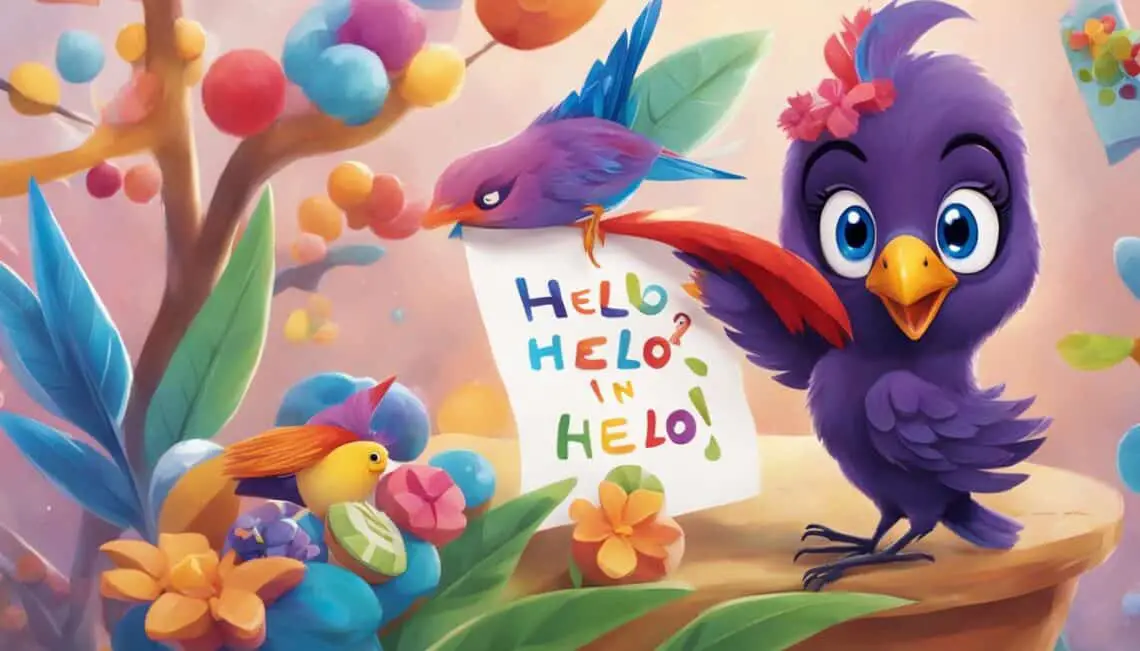
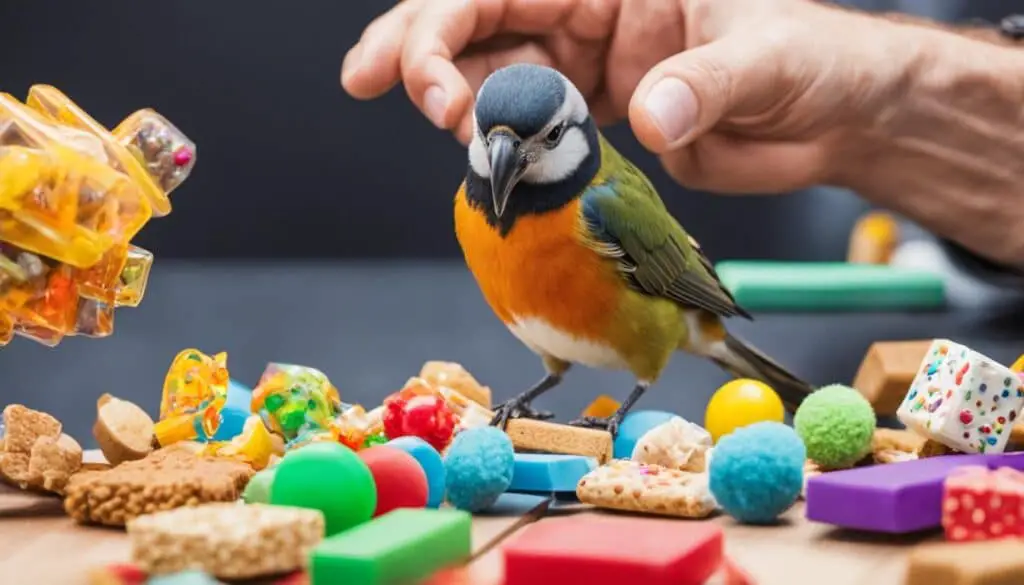
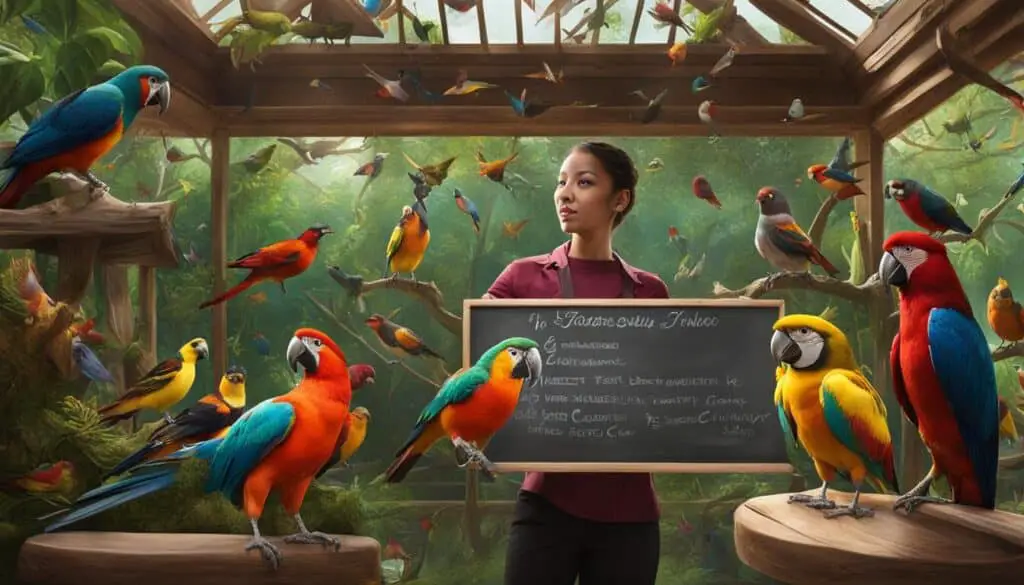
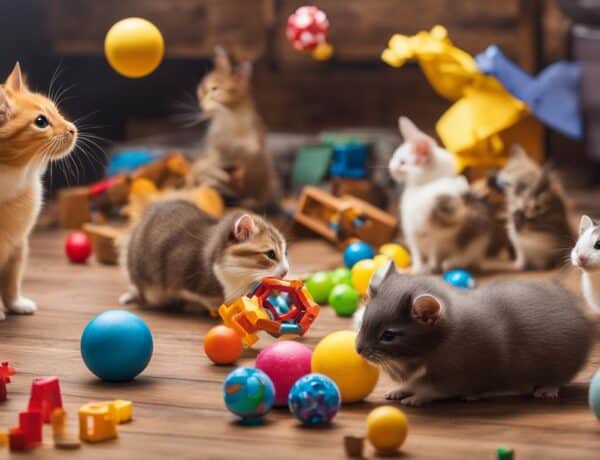

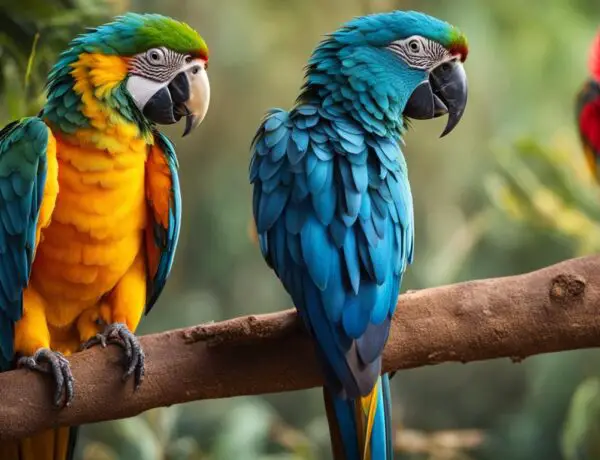
No Comments